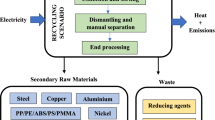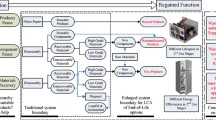Abstract
Purpose
With the tremendous growth in the worldwide electronic information and telecommunication industries, there continues to be an increasing awareness of the environmental impacts related to the accelerating mass production, electricity use, and waste management of electrical and electronic products (e-products). Although Macau is a small region with a total land area of about 29.5 km2 and a population of 557,000 in 2011, there are two personal computers (PCs) for every household in Macau.
Methods
This paper aims to describe the application of life cycle assessment (LCA) to investigate the environmental performance of PCs in Macau. An assessment of the PC (focusing on the desktop PC) was carried out using a detailed modular LCA based on the international standards of the ISO 14040 series. The LCA was constructed using SimaPro software version 7.2 and expressed with both the Eco-indicator'99 method and the Centrum voor Milieuwetenschappen method. Life cycle inventory information was compiled by Ecoinvent 2.2 databases, combined with literature and field investigations of the actual situations.
Results and discussion
The established LCA study showed that the manufacturing and the use of such devices are of the highest environmental importance. In the manufacturing stage, the desktop contributes the most to the total environmental impacts (44.89 Pt), followed by the LCD screens (about 27.53 Pt), while the CRT screen, keyboard, and mouse are of minor importance. During the use phase, the environmental impact is due entirely to the consumption of electricity generated by coal, oil, natural gas, and hydropower. The electricity generated by coal is by far the most important, accounting for about 66 % of the total environmental impact, followed by oil and gas. Within the EoL treatment phase, using incineration, there will be little environmental impact. When adopting recycling technology in the EoL phase, apparent environmental benefits will be generated due mainly to avoiding emissions to water (arsenic ions and cadmium ions) and to air (SO2) in the primary production phase. For the competing technologies of CRT and LCD screens, the environmental impacts are different in different phases, but the total impacts over their entire life cycle are similar.
Conclusions
Results from a life cycle assessment can be used to compare the relative environmental impacts of competing technologies; it can also help designers and managers to focus efforts toward making environmental improvements to a particular technology.













Similar content being viewed by others
References
Anders ASG, Andersen O (2010) Life cycle assessments of consumer electronics—are they consistent? Int J Life Cycle Assess 15:827–836
Andrae ASG (2011) European LCA standardization of ICT: equipment, networks, and services. In: Finkbeiner M (ed) Towards life cycle sustainability management, 1st edn. Springer, Berlin. Aug. 28–31, Berlin, Germany, pp 483–493
Andrae ASG, Norihiro I, Hiroshi Y, Atsushi I (2008) Life cycle assessment of Japanese high-temperature conductive adhesives. Environ Sci Technol 42:3084–3089
Asari M, Fukui K, Sakai S (2008) Life-cycle flow of mercury and recycling scenario of fluorescent lamps in Japan. Sci Total Environ 393(1):1–10
Bakri SNS, Ramasamy RK, Surif S (2010) Life cycle assessment of magnetic and electronic ballast for 36-W fluorescent lamp. Int J Life Cycle Assess 15:837–841
Choi B, Shin H, Lee S, Hur T (2006) Life cycle assessment of a personal computer and its effective recycling rate. Int J Life Cycle Assess 11(2):122–128
Consoli F, Allen D, Boustead I, Fava J, Franklin W, Jensen AA (1993) Guidelines for life-cycle assessment: a ‘code of practice’. Society of Environmental Toxicology and Chemistry (SETAC) (SETAC Workshop, Sesimbra, Portugal, 31 March–3 April 1993)
Deng W, Zheng J, Bi X, Fu J, Wong M (2007) Distribution of PBDEs in air particles from an electronic waste recycling site compared with Guangzhou and Hong Kong, South China. Environ Int 33(8):1063–1069
Duan H, Eugster M, Hischier R, Streicher-Porte M, Li J (2009) Life cycle assessment study of a Chinese desktop personal computer. Sci Total Environ 407:1755–1764
European Telecommunications Standards Institute (2011) ETSI TS 103 199 V1.1.1 (2011-11) Environmental Engineering (EE); Life Cycle Assessment (LCA) of ICT equipment, networks and services; General methodology and common requirements. http://www.etsi.org/deliver/etsi_ts/103100_103199/103199/01.01.01_60/ts_103199v010101p.pdf
Fang GC, Wu YS, Huang SH, Rau JY (2005) Review of atmospheric metallic elements in Asia during 2000–2004. Atmos Environ 39:3003–3013
Guinee J, Gorrée M, Heijungs R, Huppes G, Kleijn R, de Koning A et al (2001) Life cycle assessment—an operational guide to the ISO standards. Leiden University: Centre of Environmental Sciences (CML)
Hertwich EG, Roux C (2011) Greenhouse gas emissions from the consumption of electric and electronic equipment by Norwegian households. Environ Sci Technol 45:8190–8196
Hischier R, Baudin I (2010) LCA study of a plasma television device. Int J Life Cycle Assess 15:428–438
Huisman J (2003) Quantifying recyclability and eco-efficiency for end-of-life treatment of consumer electronic products. PhD thesis, Delft University of Technology
ISO (International Standard Organization) (2000) 14040 series: environmental management—life cycle assessment—principles and framework. ISO 14040 series. http://www.iso.org/iso/iso_catalogue/catalogue_tc/catalogue_detail.htmc?csnumber-37456. (Accessed 29 Feb 2012)
Leung AOW, Duzgoren-Aydin NS, Cheung KC, Wong MH (2008) Heavy metals concentrations of surface dust from e-waste recycling and its human health implications in Southeast China. Environ Sci Technol 42(7):2674–2780
LG (LCA Guide) (1997) A guide to approaches, experiences and information source. Environmental Issue Series No. 6. European Environmental Agency
Li H, Yu L, Sheng G, Fu J, Peng P (2007) Severe PCDD/F and PBDD/F pollution in air around an electronic waste dismantling area in China. Environ Sci Technol 41(16):5641–5646
Liu H, Zhou Q, Wang Y, Zhang Q, Cai Z, Jiang G (2008) E-waste recycling induced polybrominated diphenyl ethers, polychlorinated biphenyls, polychlorinated dibenzo-p-dioxins and dibenzo-furans pollution in the ambient environment. Environ Int 34(1):67–72
Morf LS, Tremp J, Gloor R, Schuppisser F, Stengele M, Taverna R (2007) Metals, non-metals and PCB in electrical and electronic waste—actual levels in Switzerland. Waste Manag 27:1306–1316
Pennington DW, Potting J, Finnveden G, Lindeijer E, Jolliet O, Rydberg T et al (2004) Life cycle assessment Part 2: current impact assessment practice. Environ Int 30(5):721–739
Prasara J, Grant T (2011) Comparative life cycle assessment of uses of rice husk for energy purposes. Int J Life Cycle Assess 16:493–502
Puckett J, Byster L, Westervelt S, Gutierrez R, Davis S, Hussain A et al (2002) Toxics link India exporting harm, the high-tech trashing of Asia. The Basel Action Network (BAN) and Silicon Valley Toxics Coalition (SVTC); Seattle, WA, USA, February 25
Qu W, Bi X, Sheng G, Lu S, Fu J, Yuan J et al (2007) Exposure to polybrominated diphenyl ethers among workers at an electronic, waste dismantling region in Guangdong, China. Environ Int 33(8):1029–1034
Rebitzer G, Ekvall T, Frischknecht R, Hunkeler D, Norris G, Rydberg T et al (2004) Life cycle assessment Part 1: framework, goal and scope definition, inventory analysis, and applications. Environ Int 30(5):701–720
Rivela B, Moreira MT, Muñoz I, Rieradevall J, Feijoo G (2006) Life cycle assessment of wood wastes: a case study of ephemeral architecture. Sci Total Environ 357(1–3):1–11
Robinson BH (2009) E-waste: an assessment of global production and environmental impacts. Sci Total Environ 408:183–191
Saner D, Walser T, Vadenbo CO (2012) End-of-life and waste management in life cycle assessment—Zurich, 6 December 2011. Int J Life Cycle Assess 17(4):504–510
Scharnhorst W, Althaus H-J, Classen M, Jolliet O, Hilty LM (2005) The end-of-life treatment of second generation mobile phone networks: strategies to reduce the environmental impact. Environ Impact Assess Rev 25(5):540–566
Scharnhorst W, Hilty LM, Jolliet O (2006) Life cycle assessment of second generation (2G) and third generation (3G) mobile phone networks. Environ Int 32(5):656–675
Sepúlveda A, Schluep M, Renaud FG, Streicher M, Streicher R, Hagelüken C, Gerecke AC (2010) A review of the environmental fate and effects of hazardous substances released from electrical and electronic equipments during recycling: examples from China and India. Environ Impact Assess Rev 30:28–41
Socolof ML, Overly JG, Geibig JR (2005) Environmental life-cycle impacts of CRT and LCD desktop computer displays. J Clean Prod 13:1281–1294
Song Q, Wang Z, Li J, Duan H (2012a) Sustainability evaluation of an e-waste treatment enterprise based on energy analysis in China. Ecol Eng 42:223–231
Song Q, Wang Z, Li J (2012b) Residents’ behaviors, attitudes, and willingness to pay for recycling e-waste in Macau. J Environ Manage 106:8–16
Teehan P, Kandlikar M (2012) Sources of variation in life cycle assessments of desktop computers. J Ind Ecol 16:S182–S194
Tekwawa M, Miyamoto S, Inaba A (1997) Life cycle assessment: an approach to environmentally friendly PCs. Electronics and the environment. Proceedings of the 1997 IEEE international symposium on 5–7 May 1997, San Francisco, CA, USA
UNU (United Nations University) (2008) Review of Directive 2002/96 on Waste Electrical and Electronic Equipment
Wäger PA, Hischier R, Eugster M (2011) Environmental impacts of the Swiss collection and recovery systems for Waste Electrical and Electronic Equipment (WEEE): a follow-up. Sci Total Environ 409:1746–1756
Widmer R, Oswald-Krapf H, Sinha-Khetriwal D, Schnellmann M, Böni H (2005) Global perspectives on e-waste. Environ Impact Assess Rev 25(5):436–458
Witoon A, Pornpote P, Daniel JW, Woranut K (2008) LCA of spent fluorescent lamps in Thailand at various rates of recycling. J Clean Prod 16:1046–1061
Wittmaier M, Langer S, Sawilla B (2009) Possibilities and limitations of life cycle assessment (LCA) in the development of waste utilization systems—applied examples for a region in Northern Germany. Waste Manag 29:1732–1738
Wong CSC, Duzgoren-Aydin NS, Aydin A, Wong MH (2007) Evidence of excessive releases of metals from primitive e-waste processing in Guiyu, China. Environ Pollut 148(1):62–72
Acknowledgments
The authors would like to thank Dr. Duan Huabo (Tsinghua University) for his constructive and detailed reviews of this manuscript. This study was funded by the National High Technology Research and Development Program of China (863 program, 2009AA06Z304), and the University of Macau.
Author information
Authors and Affiliations
Corresponding author
Additional information
Responsible editor: Roland Hischier
Rights and permissions
About this article
Cite this article
Song, Q., Wang, Z., Li, J. et al. Life cycle assessment of desktop PCs in Macau. Int J Life Cycle Assess 18, 553–566 (2013). https://doi.org/10.1007/s11367-012-0515-7
Received:
Accepted:
Published:
Issue Date:
DOI: https://doi.org/10.1007/s11367-012-0515-7




